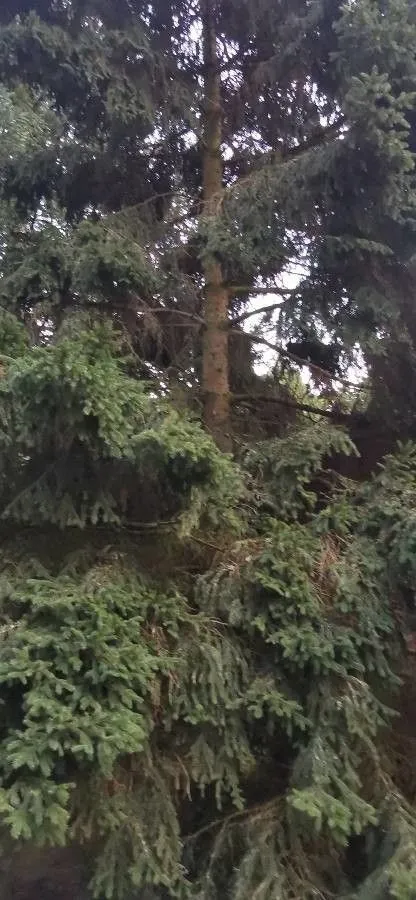
Author: Ledeb.
Bibliography: Fl. Altaic. 4: 201 (1833)
Year: 1833
Status: accepted
Rank: species
Genus: Picea
Vegetable: False
Observations: N. Europe to Russian Far East and Mongolia
The Siberian spruce, scientifically known as Picea obovata, stands as a compelling example of nature’s resilience and adaptability, thriving across a diverse range of environments from Northern Europe to the Russian Far East and Mongolia. This evergreen conifer, a proud member of the Pinaceae family, was meticulously documented by Ledeb. in the renowned botanical reference Fl. Altaic. 4: 201 in 1833.
Characterized by its conical shape and dense foliage, the Siberian spruce is often appreciated not only for its aesthetic appeal but also for its functional attributes in forestry and landscape design. The tree rises with a majestic stature, its branches elegantly arching downward, creating a striking silhouette against its native cool, temperate climes.
The needles of Picea obovata emit a subtle, fragrant aroma, typically measuring 1 to 2 centimeters in length. These needles are usually dark green or bluish-green, contributing to the tree’s robust, verdant appearance year-round. Its bark, greyish-brown and flaky, provides a textured contrast to the smooth, linear arrangement of its needles.
Siberian spruce cones are cylindrical and fairly slender, ripening from a lush green to a light brown as they mature. These cones play a crucial role in the tree’s reproductive cycle, dispersing seeds that ensure the perpetuation of the species across its extensive range. The seeds themselves are small and lightweight, adapted for dispersion by wind, which aids the tree’s spread across vast and varied terrains.
In its natural habitat, Picea obovata often dominates subarctic and boreal forests, contributing significantly to the ecological stability of these areas. It thrives in well-drained soils, typically preferring cooler environments where it can withstand harsh winters and short growing seasons. The tree’s adaptability allows it to endure severe climatic conditions, making it an essential component of the forest ecosystems where it resides.
Moreover, the Siberian spruce holds economic value. Its wood is prized for its strength and uniform grain, often used in construction, paper production, and as a source of fuel in its native regions. Additionally, the tree holds cultural significance for various indigenous communities, who utilize different parts of the tree for traditional practices and crafts.
In essence, the Siberian spruce, Picea obovata, not only enriches the forests of Northern Europe, the Russian Far East, and Mongolia with its presence but also serves numerous ecological, economic, and cultural functions. Its sturdy branches and vibrant needles stand as a testament to the enduring beauty and utility of this remarkable species.
Ita: abete siberiano
Deu: altai-fichte, siberische fichte, sibirische fichte
Eng: siberian spruce
Nor: sibirgran
Hun: szibériai luc
Fra: sapinette de sibérie, épicéa de sibérie
Rus: ель сибирская (el’ sibirskaya), jel sibirskaya
Zho: 纱松 (sha song), 西伯利亚云杉 (xian bei yun shan)
En: Siberian spruce
Ar: تنوب بيضي
Hy: Եղևնի սիբիրական
Az: Sibir küknarı
Be: Елка сібірская
Bg: Сибирски смърч
Zh: Xian bei yun shan, 新疆云杉, 纱松 (sha song), 西伯利亚云杉 (xian bei yun shan)
Cs: Smrk sibiřský
Eo: Siberia piceo
Et: Siberi kuusk
Fi: Siperiankuusi
Fr: Épicéa de Sibérie, Sapinette de Sibérie
De: Sibirische Fichte, Altai-Fichte, Siberische Fichte
Hu: Szibériai luc
Is: Síberíugreni
It: Abete siberiano
Kv: Сибирись кӧз
Lt: Sibirinė eglė
Mn: Сибирь жодоо
No: Sibirgran
Fa: نوئل سیبری
Pl: Świerk syberyjski
Ru: Ель сибирская, Ель сибирская (el’ sibirskaya), Jel Sibirskaya
Zh-hant: 新疆雲杉
Tr: Sibirya ladini
Uk: Ялина сибірська
Taken Sep 8, 2021 by Dieter Albrecht (cc-by-sa)
Taken Sep 8, 2021 by Dieter Albrecht (cc-by-sa)
Taken Sep 8, 2021 by Dieter Albrecht (cc-by-sa)
Taken Sep 8, 2021 by Dieter Albrecht (cc-by-sa)
Taken Aug 10, 2022 by Daniel Bäck (cc-by-sa)
© copyright of the Board of Trustees of the Royal Botanic Gardens, Kew.
Family: Myrtaceae Author: (F.Muell.) K.D.Hill & L.A.S.Johnson Bibliography: Telopea 6: 402 (1995) Year: 1995 Status:…
Family: Rubiaceae Author: Pierre ex A.Froehner Bibliography: Notizbl. Bot. Gart. Berlin-Dahlem 1: 237 (1897) Year:…
Family: Sapindaceae Author: Koidz. Bibliography: J. Coll. Sci. Imp. Univ. Tokyo 32(1): 38 (1911) Year:…
Family: Asteraceae Author: A.Gray Bibliography: Pacif. Railr. Rep.: 107 (1857) Year: 1857 Status: accepted Rank:…
Family: Fabaceae Author: Medik. Bibliography: Vorles. Churpfälz. Phys.-Ökon. Ges. 2: 398 (1787) Year: 1787 Status:…
Family: Aspleniaceae Author: (Cav.) Alston Bibliography: Bull. Misc. Inform. Kew 1932: 309 (1932) Year: 1932…